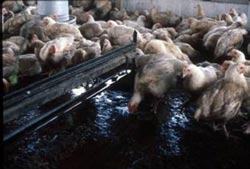



Biosecurity for the Poultry Industry
"It really does not matter how comprehensive your biosecurity measures are on paper but rather whether the programme is implemented correctly in farms," write Gary Butcher and Mojtaba Yegani for the Florida Cooperative Extension Service. They explain why biosecurity has become vital to today's poultry industry, and the importance of putting all aspects of the programme in place before a disease outbreak.There has been tremendous growth in the global poultry industry over the past few decades. Some regions have reported a dramatic increase in the incidence of infectious disease outbreaks during this time of rapid expansion. In spite of the difficult challenges that the industry has been facing, poultry products (meat and eggs) still represent a major part of animal protein consumed by humans at the global level.
Today's consumers are generally more health-conscious and react strongly to perceived safety issues associated with consumption of products of animal origin. Mad cow disease (BSE), avian influenza (AI) and salmonellosis are just a few examples of these contemporary concerns. In these days where the media tend to create hype rather than reporting the news, it is even more important to maintain a continuous vigilance to keep consumer confidence in poultry products.
Poultry Health Status


The end result of these diseases is reduced economic returns to producers. The emergence of new diseases and variants of existing diseases are becoming more common in the industry. Genetic changes in the microorganisms might have, in part, contributed to this situation. Similarly, genetic changes in the birds might have also altered their susceptibility or resistance to diseases. Global trading and traveling have made it difficult to keep diseases to limited areas or regions.
Complex Interactions
There are complex interactions among poultry, disease agents, and the environment. Factors directed at specific or non-specific immunity of the birds can affect their ability to resist disease if exposure to the agent occurs. Activities directed at the disease agents mainly influence the exposure of the birds to the agent. Environmental factors can also affect both the birds and the disease agent.Current Situation
With the current tendency for regulatory agencies, in many parts of the world, to further limit the use of antibiotic growth promoters and therapeutic antibiotics, more effort must be directed to disease preventive strategies rather than use of pharmacologic treatments. There are different sources or methods that can introduce diseases into a farm or spread infections within or between farms. These include:- Human (employees, visitors)
- Airborne transmission
- Carrier birds within a flock
- Birds in hospital/cull pen in a poultry house
- Birds recently obtained from an outside flock
- Forced-moulted hens
- Eggs from infected breeder flocks
- Backyard, pet fowl and wild birds
- Pet animals, rodents and insects
- Live-bird markets
- Contaminated feed and water and
- contaminated vaccines.
What Happens Next?


With the tendency for larger farms and with higher bird density, the above mentioned methods of disease spread can, directly or indirectly, contribute to dissemination of infectious agents. There could be severe losses following a disease outbreak or the emergence of a more pathogenic form of a given disease.
Sub-optimal performance due to a disease can result in economic losses although there are no exact estimates of losses associated with diseases. Specific factors such as the virulence of the agent, the immune status of the flock, previous exposure to immunosuppressive agents or conditions, housing design, stocking density, and environmental conditions are all variables that can influence the extent of losses following a disease outbreak.
Biosecurity: an Old Concept
Biosecurity is a term frequently used in the poultry industry over the past decades. Many people believe that biosecurity only involves implementing a strict visitor control and farm cleaning programme. In reality, a comprehensive biosecurity programme includes many other components. In any commercial poultry operation, flock health must be excellent in order to achieve maximum profitability. Health status can often be directly correlated with the comprehensiveness of the biosecurity programme implemented in an operation. It should also be noted that competence of the immune system of birds is of critical importance.
Biosecurity is the efficient use of common sense hygiene procedures in preventing the adverse effects of a disease. It can be defined as a set of management practices which, when followed, reduce the potential for the introduction or spread of disease agents onto and across the site.
In other words, biosecurity is an essential component of a disease control programme in the poultry industry. Table 1 presents some of important considerations in designing a comprehensive biosecurity. Clearly, a biosecurity plan must be adapted for each operation because each operation usually has its own unique situations. There is no standard formula applicable to all poultry commercial farms.

A Comprehensive Biosecurity Programme
When a disease outbreak occurs, people tend to point fingers at someone or something else as being responsible for introduction of the disease agent. This is definitely the wrong approach. Under these circumstances, everyone should make an effort to keep an open mind and to help investigate how the problem began in the first place.The objective is to solve the problem and not simply determine who was at fault. Problems need to be correctly diagnosed by all available means, otherwise they may recur in the next production cycle or on other farms within the company. The worst excuses that are often heard during a disease outbreak are "Nobody told me that before" or "I did not know that". Thus, it is imperative that all employees at all levels have a complete understanding regarding the policy on the biosecurity programme. It is recommended to make check-lists and ensure that training is on-going, even when times are good and no diseases are present.
A biosecurity programme should be applied with the same intensity to all sectors of a company. It must be practical and easily understood by everyone within the company. Complicated biosecurity programmes, which are not easy to implement, will fail. Consistency in following biosecurity rules throughout the year, i.e. production cycle, is very important.
Biosecurity programme implementation comes at little cost when compared to the costs associated with a disease outbreak.
Biosecurity is a necessary expense and can make a difference between success and failure in a poultry operation (see figures).
A Few Examples
Avian influenza
This disease has caused problems for birds and, in rare instances, humans. The disease is being found in more regions around the globe and is even endemic in the poultry industries in several countries. Outbreaks of avian influenza over the past 10 years indicate that current levels of biosecurity in different parts of the world are inadequate to limit dissemination of this disease.Infectious bursal disease (IBD)
IBD continues to be one of the most important diseases of poultry, with high rates of morbidity and mortality. This disease can be controlled by routine vaccination and a solid biosecurity program. Inadequate control programs including biosecurity measures will not only increase the risk of IBD but also open the door to many other diseases such as Marek's disease.Newcastle disease and infectious bronchitis
Newcastle disease (NDV) continues as a major problem in different parts of the world. Protection of flocks against NDV requires a solid biosecurity and vaccination program. In many intensive broiler and egg production regions, variants of infectious bronchitis virus (IBV) have emerged causing respiratory infections in broilers, decreased egg production and degraded shell quality in breeders and commercial layer flocks.Concluding Remarks
In commercial integrations, poultry diseases occur separately or in combination with other infectious agents and management problems.Immunosuppressive infections with agents such as infectious bursal disease, chicken infectious anaemia and Marek's disease predispose flocks to the effects of respiratory viruses such infectious bronchitis, Newcastle disease and infectious laryngotracheitis. Opportunistic bacteria including virulent E. coli, often complicate these infections. The fight against these agents will be an on-going effort and biosecurity measures must be the first line of defence in this battle.
In spite of strict control measures, no one can guarantee that everything will always go as planned. It really does not matter how comprehensive your biosecurity measures are on paper, but rather whether the programme is implemented correctly in farms. It is often said that a comprehensive biosecurity programme that is properly implemented will not eliminate the possibility of disease but will reduce the probability. When a disease outbreak occurs, this generally indicates that there has been a breakdown in the programme's implementation.
As the industry continues to develop and become even more competitive, it is clear that a solid biosecurity programme is essential for a company to survive and remain profitable in the poultry business.
Gary D. Butcher is Professor and poultry veterinarian at the College of Veterinary Medicine, Institute of Food and Agricultural Sciences, University of Florida. Mojtaba Yegani is poultry veterinary consultant at the Department of Agricultural, Food and Nutritional Science at the University of Alberta in Canada and at Florida Cooperative Extension Service, Institute of Food and Agricultural Sciences, University of Florida.
February 2009








